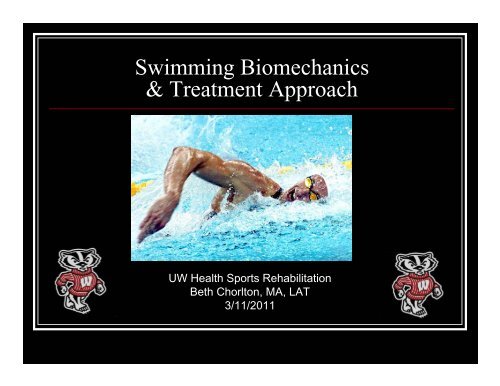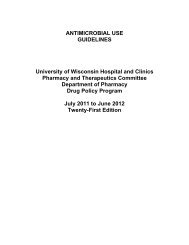Swimming Biomechanics and Injury Treatment (pdf) - UW Health
Swimming Biomechanics and Injury Treatment (pdf) - UW Health
Swimming Biomechanics and Injury Treatment (pdf) - UW Health
Create successful ePaper yourself
Turn your PDF publications into a flip-book with our unique Google optimized e-Paper software.
<strong>Swimming</strong> <strong>Biomechanics</strong><br />
& <strong>Treatment</strong> Approach<br />
<strong>UW</strong> <strong>Health</strong> Sports Rehabilitation<br />
Beth Chorlton, MA, LAT<br />
3/11/2011
Competitive <strong>Swimming</strong> Prevalence<br />
• US <strong>Swimming</strong><br />
Population:<br />
100-120 million<br />
• 250,000+ registered with<br />
USA swimming.<br />
• 38,000+ US Masters<br />
<strong>Swimming</strong> members<br />
• 5 million+ participate in<br />
HS <strong>and</strong> summer<br />
swimming<br />
Kammer et al, 1999
Training Load<br />
• Freestyle is most common training stroke<br />
• Pool Work<br />
• Competitive swimmers train 10,000-20,000 yds/day.<br />
• 40,000 shoulder rotations/per arm/per week<br />
• Stroke technique is critical<br />
• Dry l<strong>and</strong> Work<br />
• Strength training<br />
• Dry-l<strong>and</strong> conditioning<br />
• Cross-training (circuits, running, cycling)
<strong>Swimming</strong> <strong>Injury</strong> Epidemiology<br />
• Shoulder<br />
• Knee- breastrokers<br />
• Back-DDD,<br />
Spondylolysis,<br />
Spondylolisthesis
<strong>Swimming</strong> <strong>Injury</strong> Epidemiology<br />
• Prevalence of shoulder pain in elite<br />
swimmers<br />
• 3% in 1974 – “Swimmer’s Shoulder”<br />
• 42% in 1980<br />
• 40-69% in 1994<br />
• 47% lifetime incidence of shoulder injuries in<br />
collegiate swimmers <strong>and</strong> 48% in masters<br />
swimmers<br />
Sein et al, BJSM, 2010
Shoulder Pain Epidemiology<br />
• Pink et al (2000): survey of 233 collegiate<br />
swimmers on pain location.<br />
• Anterior-Superior: 44%<br />
• Diffuse pain: 26%<br />
• Anterior-Inferior: 14%<br />
• Posterior-Superior: 10%<br />
• Posterior-Inferior: 4%
Biomechanical Dem<strong>and</strong>s of <strong>Swimming</strong><br />
• Outside humans natural environment<br />
• Specific actions needed for breathing<br />
• No firm surface against which to generate<br />
forces.<br />
• Propulsion by upper limbs<br />
• Negative effects of water drag
<strong>Biomechanics</strong> of Freestyle<br />
• 4 Phases of Freestyle<br />
• Entry/Catch<br />
• Early Pull/Pull<br />
• Push<br />
• Exit/Recovery
Entry/Catch<br />
• H<strong>and</strong> entry in line with<br />
shoulder <strong>and</strong> at wrist level<br />
• Slight IR pitch to h<strong>and</strong> ~ 40°,<br />
open h<strong>and</strong><br />
• Elbow straightens to get long<br />
glide<br />
• Elbow bends slightly <strong>and</strong><br />
remains on the surface for<br />
catch <strong>and</strong> preps for pull<br />
• Opposite arm pull on entry<br />
• Opposite leg kick
Early Pull/Pull<br />
• High shoulder <strong>and</strong> high<br />
elbow position<br />
• Elbow bent for pulling<br />
<strong>and</strong> IR<br />
• Forearm vertical at mid<br />
pull<br />
• Body rotation continuous<br />
• Pulling body past a<br />
stationary arm, NOT<br />
pushing water back.
Push<br />
• From vertical forearm<br />
position to hip<br />
• Power thru core <strong>and</strong><br />
axial rotation<br />
• Need > 40° rotation to<br />
clear the hip<br />
• Arm continues to<br />
accelerate<br />
• Elbow exits first
• Elbow exits first, then<br />
5 th digit<br />
• Trunk rotation<br />
necessary to avoid<br />
horizontally abduction<br />
beyond bodyline<br />
• Elbow leads<br />
recovery, then h<strong>and</strong><br />
leads elbow<br />
Exit/Recovery
• Power <strong>and</strong> propulsion<br />
from hip <strong>and</strong> knee<br />
extension<br />
• Efficient kick takes<br />
stress off shoulder<br />
• Ankle PF<br />
• Stabilize core<br />
• 2 beat/4 beat/6 beat<br />
Kick
Head Position/Breathing<br />
• Slight cervical<br />
extension vs. neutral<br />
• Alignment of<br />
head/trunk/hips<br />
• Breathe at beginning<br />
of recovery<br />
• Bilateral breathing
Freestyle
Common Freestyle Mechanical Changes Caused<br />
by Fatigue, Soreness <strong>and</strong> Pain
Thumb First Entry<br />
Freestyle Stroke Flaw<br />
• Over developed IR<br />
• Weak/fatigued ER<br />
• Coached to improve<br />
catch/early pull<br />
• Poor motor program
Crossover at Entry<br />
Freestyle Stroke Flaw<br />
• Poor scapular control<br />
• Poor trunk rotation<br />
• GH hypermobility<br />
• Poor motor<br />
control/proprioception
• <strong>Swimming</strong> “flat”<br />
Freestyle Stroke Flaw<br />
• Poor motor program<br />
• Poor core strength<br />
• Poor kick<br />
• Anterior pelvic tilt
• Excessive IR in<br />
Recovery<br />
• Weak ER<br />
• RTC fatigue<br />
• Posture<br />
Freestyle Stroke Flaw<br />
• Coached for high elbow<br />
or “finger tip” drill
• Poor Timing<br />
Freestyle Stroke Flaw<br />
• Poor core strength<br />
• Poor balance in water<br />
• Poor motor program
Good Timing of Freestyle stroke
The Question...<br />
Why has this swimmer<br />
have this injury<br />
at this time?
Etiology of<br />
Shoulder Pain in Swimmers<br />
• Intrinsic Factors<br />
• Scapular dyskinesis<br />
• Muscular imbalance<br />
• Joint mobility (hyper/hypo)<br />
• Posture/increased thoracic kyphosis<br />
• Core stability<br />
• Inflexibility (pecs, lats, hip flexors)
Etiology of<br />
Shoulder Pain in Swimmers<br />
• Extrinsic Factors<br />
• Training load- absolute <strong>and</strong> sudden increase<br />
• Stroke flaws/error<br />
• Stroke specialty<br />
• Sprinter/Mid/Distance<br />
• Training environment (pool/dryl<strong>and</strong>/Xtrain)
Research Updates
Research - Impingement<br />
• 4 areas of impingement recognized in the literature<br />
• Subacromial<br />
• Posterosuperior Internal<br />
• Anterosuperior Internal<br />
• Coracoid<br />
• Subacromial impingement: compression <strong>and</strong><br />
abrasion of bursal side <strong>and</strong> subacromial structures<br />
between the humeral head <strong>and</strong> coracoacromial arch
Research - Impingement<br />
• Mechanical impingement occurs 25% of<br />
freestyle stroke cycle in swimmers<br />
(Yanai & Hay, 2000)
Research - Impingement<br />
• 40% of impingement occurs at entry<br />
• 40% during recovery<br />
• 20% during the pull<br />
(Pink & Timone, 2000)
Research - Muscle activity<br />
• Normal muscle activity during freestyle<br />
• 15-20% of a muscles maximal voluntary contraction is<br />
the highest level at which sustained activity can occur<br />
without fatigue (Monod et al, 1985)<br />
• Pink et al, AJSM, 1991<br />
• EMG study on 12 muscles in 20 swimmers w/o shoulder<br />
pain<br />
• Subscapularis <strong>and</strong> Serratus Anterior are constantly fire<br />
at more than 20% of the maximum
Research - Muscle activity<br />
• Abnormal muscle activity during freestyle<br />
• Scovazzo et al, AJSM, 1991<br />
• EMG study of 12 shoulder muscles in 14 swimmers with<br />
shoulder pain<br />
• During pulling, significantly less activity in SA <strong>and</strong> more in<br />
rhomboids.
Research – Muscle Activity
Research – Joint Laxity<br />
• Many authors have examined GH laxity in<br />
swimmers <strong>and</strong> concluded that swimmers<br />
have great GH laxity <strong>and</strong> general joint laxity<br />
• Jobe described the “instability complex”
Research – Joint Laxity<br />
• Borsa et al, AJSM 2005<br />
• 42 NCAA Div 1 swimmers<br />
• 44 age matched controls<br />
• US imaging of GH laxity<br />
• No difference in GH laxity between swimmers<br />
<strong>and</strong> age matched controls<br />
• No difference in GH laxity between painful <strong>and</strong><br />
non-painful swimmers
Research – Joint Laxity<br />
• Sein et al, BJSM 2010<br />
• 80 elite swimmers (13-25<br />
yo)<br />
• Training questionnaire,<br />
PE, laxometer, MRI<br />
• 91% complained of<br />
shoulder pain<br />
• 84% impingement sign<br />
• 69% SSPS tendinopathy<br />
Inferior glide
Research – Joint Laxity<br />
• Sein et al, BJSM 2010<br />
• All swimmers with SSPS thickening had a<br />
+ impingement sign <strong>and</strong> SSPS tendinopathy<br />
• ++ correlation between SSPS tendinopathy <strong>and</strong> # of<br />
hours swum each week (> 15 hours/week)<br />
• SSPS tendinopathy in swimmers is induced by large<br />
training loads<br />
• Shoulder laxity has only a minimal association with<br />
shoulder impingement in elite swimmers
Summary<br />
• Muscular fatigue <strong>and</strong> training load appear<br />
to have a greater influence on shoulder<br />
pain than joint laxity based on new<br />
research<br />
• Key is to get swimmers in early, eval/treat<br />
impairments, swim stroke analysis, modify<br />
training as needed
Looking Forward…<br />
• More research is<br />
needed on age group<br />
<strong>and</strong> high school<br />
swimmers<br />
• Is there a place for<br />
“yardage count” for<br />
younger athletes

















